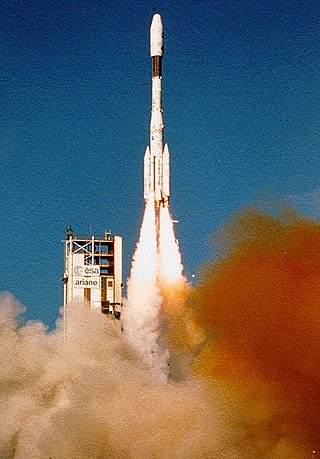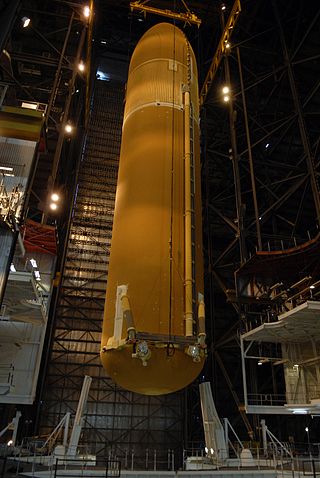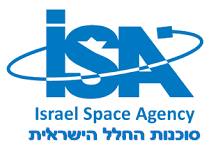A resistojet is a method of spacecraft propulsion that provides thrust by heating a typically non-reactive fluid. Heating is usually achieved by sending electricity through a resistor consisting of a hot incandescent filament, with the expanded gas expelled through a conventional nozzle.

A spacecraft is a vehicle or machine designed to fly in outer space. A type of artificial satellite, spacecraft are used for a variety of purposes, including communications, Earth observation, meteorology, navigation, space colonization, planetary exploration, and transportation of humans and cargo. All spacecraft except single-stage-to-orbit vehicles cannot get into space on their own, and require a launch vehicle.

Ariane is a series of European civilian expendable launch vehicles for space launch use. The name comes from the French spelling of the mythological character Ariadne. France first proposed the Ariane project and it was officially agreed upon at the end of 1973 after discussions between France, Germany and the UK. The project was Western Europe's second attempt to develop its own launcher following the unsuccessful Europa project. The Ariane project was code-named L3S.

Columbus is a science laboratory that is part of the International Space Station (ISS) and is the largest single contribution to the ISS made by the European Space Agency (ESA).

The Automated Transfer Vehicle, originally Ariane Transfer Vehicle or ATV, was an expendable cargo spacecraft developed by the European Space Agency (ESA), used for space cargo transport in 2008–2015. The ATV design was launched to orbit five times, exclusively by the Ariane 5 heavy-lift launch vehicle. It effectively was a larger European counterpart to the Russian Progress cargo spacecraft for carrying upmass to a single destination—the International Space Station (ISS)—but with three times the capacity.

A spaceplane is a vehicle that can fly and glide like an aircraft in Earth's atmosphere and maneuver like a spacecraft in outer space. To do so, spaceplanes must incorporate features of both aircraft and spacecraft. Orbital spaceplanes tend to be more similar to conventional spacecraft, while sub-orbital spaceplanes tend to be more similar to fixed-wing aircraft. All spaceplanes to date have been rocket-powered but then landed as unpowered gliders.

The Space Shuttle external tank (ET) was the component of the Space Shuttle launch vehicle that contained the liquid hydrogen fuel and liquid oxygen oxidizer. During lift-off and ascent it supplied the fuel and oxidizer under pressure to the three RS-25 main engines in the orbiter. The ET was jettisoned just over 10 seconds after main engine cut-off (MECO) and it re-entered the Earth's atmosphere. Unlike the Solid Rocket Boosters, external tanks were not re-used. They broke up before impact in the Indian Ocean, away from shipping lanes and were not recovered.
Hopper was a proposed European Space Agency (ESA) orbital spaceplane and reusable launch vehicle. The Hopper was a FESTIP system study design.
This is an alphabetical list of articles pertaining specifically to aerospace engineering. For a broad overview of engineering, see List of engineering topics. For biographies, see List of engineers.

The Israel Space Agency is a governmental body, a part of Israel's Ministry of Science and Technology, that coordinates all Israeli space research programs with scientific and commercial goals.

The following outline is provided as an overview of and topical guide to space exploration.

In fluid dynamics, slosh refers to the movement of liquid inside another object.
PROTEUS is a 3-axis stabilized platform designed for mini-satellites weighing approximately 500 kg operating in low Earth orbit. The platform is used by six scientific satellites developed as part of the space program of the National Center for Space Studies (CNES) for the European Space Agency: Jason-1, 2 and 3, CALIPSO, CoRoT, and SMOS. The platform is developed by the satellite division of Aérospatiale.

The Johannes Kepler ATV, or Automated Transfer Vehicle 002 (ATV-002), was an uncrewed cargo spacecraft built to resupply the International Space Station (ISS). It was launched on February 16, 2011 by the European Space Agency (ESA). Johannes Kepler carried propellant, air and dry cargo weighing over 7,000 kilograms (15,000 lb), and had a total mass of over 20,000 kilograms (44,000 lb), making it, at the time, the heaviest payload launched by the ESA. The spacecraft was named after the 17th-century German astronomer Johannes Kepler.

An orbital propellant depot is a cache of propellant that is placed in orbit around Earth or another body to allow spacecraft or the transfer stage of the spacecraft to be fueled in space. It is one of the types of space resource depots that have been proposed for enabling infrastructure-based space exploration. Many different depot concepts exist depending on the type of fuel to be supplied, location, or type of depot which may also include a propellant tanker that delivers a single load to a spacecraft at a specified orbital location and then departs. In-space fuel depots are not necessarily located near or at a space station.
SSETI Express was the first spacecraft to be designed and built by European students and was launched by the European Space Agency. SSETI Express is a small spacecraft, similar in size and shape to a washing machine. On board the student-built spacecraft were three CubeSat picosatellites, extremely small satellites weighing around one kg each. These were deployed one hour and forty minutes after launch. Twenty-one university groups, working from locations spread across Europe and with very different cultural backgrounds, worked together via the internet to jointly create the satellite. The expected lifetime of the mission was planned to be 2 months. SSETI Express encountered an unusually fast mission development: less than 18 months from kick-off in January 2004 to flight-readiness.

The NASA Launch Services Program (LSP) is responsible for procurement of launch services for NASA uncrewed missions and oversight of launch integration and launch preparation activity, providing added quality and mission assurance to meet program objectives. LSP operates under the NASA Space Operations Mission Directorate (SOMD).

Vegetation and Environment monitoring on a New Micro-Satellite (VENµS) is a near polar sun-synchronous orbit microsatellite. It is a joint project of the Israeli Space Agency and CNES. The project was signed upon in April 2005 and was launched on the 2nd of August 2017. The microsatellite, which was set to cost the ISA US$20 million and CNES €10 million, was designed and built by IAI and Rafael under ISA's supervision.
The German space programme is the set of projects funded by the government of Germany for the exploration and utilisation of outer space. The space programme is run by the German Aerospace Center, who conduct research, plan, and implement the programme on behalf of the German federal government.

The Antonov An-325 is an evolution project of Antonov An-225 "Mriya" designed to launch spacecraft of various purposes into circular, elliptical and high-circle orbits, including geostationary orbit. It was planned to be an enlarged and improved version of the An-225, but it was never built.












